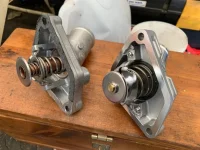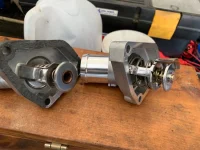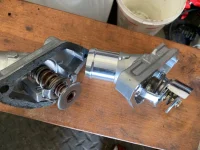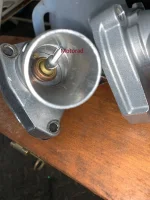I hope there's still some folks subscribed and willing to help with this! Update and recap:
Despite a couple thermostat replacements and thorough bleeding, nothing has helped. I can drive the car 100 miles with no overheating, but it'll run at 205F idle/highway cruising, and creeps up to around 215F going up hills or when there's a moderate load on the engine. That's going off ECU readout via a OBD2 scanner. That puts the needle on the gauge about 2/3 which is too high, normal should be a touch under 1/2. Have tried replacing coolant temp sensors, same result.
Today I decided to gut the thermostat. When you buy a thermostat for this car, you get the whole engine inlet housing with integrated thermostat as one piece. It's possible to cut the thermostat element out and just slap on the housing, so that's what I did.
I used the same exact coolant fill bleed procedure as before. Car warmed up as quickly as it ever did just sitting in the driveway (no airflow through radiator), and when it reached about 203F, the radiator fans kicked on just like they did before. This time, instead of peaking at 205F and staying there with cooling fans running continuously, within about 5-10 seconds the temp dropped to 195F and the cooling fans kicked off. If I let it sit idling, it would repeat that cycle, go to ~203F, cooling fans kick on, back down to 195F and repeat. This is how it's supposed to work. The cherry on top is that the lower half of radiator and lower (radiator outlet) hose is hot this whole time, whereas before it was cool to the touch.
I suppose this indicates bad thermostat? I find that crazy as I tossed the old one (in this effort) and tried TWO new ones. Should I go with an OEM thermostat this time? I did notice a lot more bubbling during engine warm-up, is it possible the lack of thermostat caused the cooling system to bleed more effectively? Thoughts?





